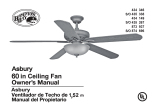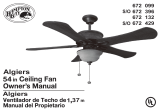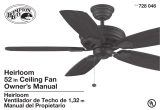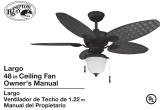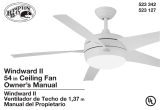Page is loading ...

42” Knit Ceiling Fan
QUESTIONS, PROBLEMS, MISSING PARTS:
Please do not return to retailer: Call 1-800-749-3267 for any missing parts or
questions regarding installation.
Please reference your SKU (355-7007)
or UPC (082392 636609).
Safety Rules ..................................1
Unpacking Your Fan ..................... 2
Installing Your Fan .......................3
Operating Your Fan ......................10
Care of Your Fan ........................... 11
Troubleshooting ...........................11
Specications ...............................12
Warranty Information ...................13
Table of Contents
UL Model No. EF200M(E)-42

1. To reduce the risk of electric shock, ensure electricity
has been turned off at the circuit breaker or fuse box
before beginning.
2. All wiring must be in accordance with the National
Electrical Code ANSI/NFPA 70-1999 and local electrical
codes. Electrical installation should be performed by a
qualied licensed electrician.
3. WARNING: To reduce the risk of re or electrical shock,
do not use this fan with any solid-state fan speed con-
trol device.
4. CAUTION: To reduce the risk of personal injury, use
only the screws provided with the outlet box.
5. The outlet box and support structure must be securely
mounted and capable of reliably supporting a minimum
of 35 pounds. Use only UL Listed outlet boxes marked
“FOR FAN SUPPORT.”
6. The fan must be mounted with a minimum of 7 feet
clearance from the trailing edge of the blades to the
oor.
7. Do not operate the reverse switch while fan blades are in
motion. Fan must be turned off and blades stopped be-
fore reversing the blade direction.
8. Avoid placing objects in the path of the blades.
9. To avoid personal injury or damage to the fan and
other items, be cautious when working around or
cleaning the fan.
10. Do not use water or detergents when cleaning the fan
or fan blades. A dry dust cloth or lightly dampened cloth
will be suitable for most cleaning.
11. After making electrical connections, spliced conductors
should be turned upward and pushed carefully up into
outlet box. The wires should be spread apart with the
grounded conductor and the equipment-grounding
conductor on one side of the outlet box.
12. Electrical diagrams are for reference only. Light kits
that are not packed with the fan must be UL listed and
marked suitable for use with the model fan you are in-
stalling. Switches must be UL general use switches.
Refer to the instructions packaged with the light kits
and switches for proper assembly. Use 60W MAX.
BULBS, Type B (supplied).
13. All set screws must be checked and tightened where
necessary before installation.
Safety Rules 1.
READ AND SAVE THESE INSTRUCTIONS
TO REDUCE THE RISK OF FIRE, ELECTRIC SHOCK OR PERSONAL
INJURY, MOUNT FAN TO OUTLET BOX MARKED “ACCEPTABLE FOR
FAN SUPPORT” WITH THE SCREWS PROVIDED WITH THE OUTLET
BOX. MOST OUTLET BOXES COMMONLY USED FOR THE SUPPORT
OF LIGHTING FIXTURES ARE NOT ACCEPTABLE FOR FAN SUPPORT
AND MAY NEED TO BE REPLACED. CONSULT A QUALIFIED ELECTRI-
CIAN IF IN DOUBT.
TO REDUCE THE RISK OF PERSONAL INJURY, DO NOT BEND THE
BLADE BRACKETS (ALSO REFERRED TO AS “FLANGES”) DURING
ASSEMBLY OR AFTER INSTALLATION. DO NOT INSERT OBJECTS IN
THE PATH OF THE BLADES.
PLEASE REMOVE RUBBER MOTOR STOPS ON THE BOTTOM OF THE
FAN BEFORE INSTALLING BLADES OR TESTING MOTOR.

a. Blade Attachment Hardware
(15 screws, rubber washers
pre-attached to the brackets)
b. Mounting Hardware
(1 Bolt, 1 Clevis Pin, 1 Rubber
Gasket)
c. Electrical Hardware & Balancing Kit
(Blade Balancing Kit, 3 Plastic Wire
Connectors, 1 Pull Chain for the Fan,
1 Pull Chain for the Light Kit, 1 Plastic
Plug for Non-Light Kit Option.)
5. Ball/downrod Assembly
6. Light Kit with Glass Shade
7. Bulbs (2)
8. Decorative Motor Collar Cover
1. Fan Motor Assembly
2. Canopy
3. Blades (5)
4. Blade Bracket Set with Rubber Washers
Pre-installed (5)
2. Unpacking Your Fan
IMPORTANT: THIS PRODUCT AND/OR COMPONENTS ARE COVERED
BY ONE OR MORE OF THE FOLLOWING U.S. PATENTS: 5,947,436;
5,988,580; 5,971,573; 6,010,110; 6,010,306; 6,039,541; 6,046,416 AND OTHER
PATENTS PENDING.
Unpack your fan and check the contents. You should have the following items:

Installing Your Fan 3.
Tools Required
Phillips screw driver, straight slot screw
driver, adjustable wrench, step ladder,
and wire cutters.
Mounting Options
If there isn’t an existing outlet box, then read
the following instructions. Disconnect the
power by removing fuses or turning off
circuit breakers.
Secure the outlet box directly to the building
structure. Use the appropriate fasteners
and building materials. The outlet box and
its support must be able to fully support the
moving weight of the fan (at least 35 lbs.)
Do not use plastic outlet boxes.
Figures 1, 2, and 3 are examples of differ-
ent ways to mount the outlet box.
Outlet Box
Note: You may need a longer downrod to
maintain proper blade clearance when
installing on a steep, sloped ceiling. The
maximum angle allowable is 30˚. If
the canopy touches the downrod, re-
move the decorative canopy bottom
cover and turn the canopy 180˚ before
attaching the canopy to the mounting
plate.
Outlet Box
To hang your fan where there is an existing
xture but no ceiling joist, you may need an
installation hanger bar as shown in
Figure 4.
TO REDUCE THE RISK OF FIRE, ELECTRIC
SHOCK OR PERSONAL INJURY, MOUNT
FAN ONLY TO AN OUTLET BOX MARKED
ACCEPTABLE FOR FAN SUPPORT AND
USE THE MOUNTING SCREWS PROVIDED
WITH THE OUTLET BOX. OUTLET BOXES
COMMONLY USED FOR THE SUPPORT OF
LIGHTING FIXTURES MAY NOT BE ACCEPT-
ABLE FOR FAN SUPPORT AND MAY NEED TO
BE REPLACED. CONSULT A QUALIFIED ELEC-
TRICIAN IF IN DOUBT.
Figure 1
Figure 2
Figure 4
Figure 3

Standard Ceiling
Mounting
1. Remove the mounting plate from the
canopy by loosening the four screws
on the top of the canopy. Remove the
two non-slotted screws and loosen the
slotted screws. This will enable you to
remove the mounting plate (Figure 5).
2. Route the wires exiting the top of the
fan motor through the motor collar cov-
er, canopy and then through the ball/
downrod assembly (Figure 6).
3. Loosen, but do not remove, the 2 set
screws on the collar on top of the mo-
tor housing.
4. Align the holes at the bottom of the
downrod with the holes in the collar
on top of the motor housing (Figure
6). Carefully insert the bolt through the
holes in the collar and downrod. Be
careful not to jam the bolt against the
wiring inside the downrod. Insert the
4.
Hanging the Fan
REMEMBER to turn off the power.
Follow the steps below to hang your
fan properly.
NOTE: This ceiling fan is supplied with two
types of hanging assemblies; the standard
ceiling installation using the downrod with
ball and socket mounting, and the “close-
to-ceiling” mounting. The “close-to-ceiling”
mounting is recommended in rooms with
less than 8-foot ceilings or in areas where
additional space is desired from the oor
to the fan blades. When using standard
downrod installation, the distance from the
ceiling to the bottom of the fan blades will be
approximately 10 inches. The “close-to-ceil-
ing” installation reduces the distance from
the ceiling to the bottom of the fan blades to
approximately 6 inches.
Once you have decided which ceiling
installation you will use, proceed with the
following instructions. Where necessary,
each section of the instructions will note the
different procedures to follow for the two
types of installation.
Figure 6
Remove
Loosen but
Do Not Remove
Figure 5
FAILURE TO PROPERLY INSTALL THE CLEVIS
PIN AS NOTED IN STEP 4 AND PROPERLY
TIGHTEN SET SCREWS AS NOTED IN STEP
5 COULD RESULT IN THE FAN LOOSENING
AND POSSIBLY FALLING.
clevis pin and bend to ensure security,
as noted in the circle inset of Figure 6.
5. Tighten the two screws on top of the fan
motor rmly (Figure 6).

5.
Figure 8
Figure 9
“Close-to-Ceiling”
Mounting
1. Remove the mounting plate from the
canopy by loosening the four screws on
the top of the canopy. Remove the two
non-slotted screws and loosen the slotted
screws. This will enable you to remove the
mounting plate (Figure 5).
2. Remove the decorative canopy bottom
cover from the canopy by depressing
the three studs (Figure 7).
3. Remove three of the six screws and lock
washers (every other one) securing the
reinforcing plate to the top of the fan mo-
tor housing (Figure 8).
4. Place the rubber gasket over the
remaining three screws, route the wires
exiting the top of the fan motor
through the ceiling canopy over
Motor
Collar Screw and
Lockwasher
(3 of 6
Screws)
FAILURE TO COMPLETELY TIGHTEN THE
THREE SCREWS IN STEP 6 COULD RESULT IN
THE FAN LOOSENING AND POSSIBLY FALLING.
Figure 7
the collar at the top of the motor
(Figure 9).
5. Align the mounting holes with the holes
in the motor and fasten, using the three
screws and lock-washers removed in
step 3 (Figure 9).
6. Tighten the mounting screws securely.
Installing Fan to
the Outlet Box
1. Pass the 120-volt supply wires through
the center hole in the ceiling mounting
plate as shown in Figure 10.
2. Install the ceiling mounting plate on the
outlet box, by sliding the mounting plate
over the two screws provided with the
outlet box. When using the close-to-
ceiling mounting, it is important that the
mounting plate be level. If necessary,
use leveling washers (not included)
between the mounting plate and the
outlet box. Note that the at side of the
mounting plate is toward the outlet box
(Figure 10).
3. Securely tighten the two mounting
screws.

4. Carefully lift the assembly up to the ceil-
ing mounting plate and hang the fan
on the hook provided by utilizing one
of the holes at the outer rim of the ceil-
ing canopy (Figure 11). If using stan-
dard mounting, seat the hanger ball in
the mounting plate socket. Make sure
the tab on the mounting plate socket
is properly seated in the groove in the
hanger ball (Figure 11).
Figure 11
Figure 10
THE HOOK AS SHOWN IN FIGURE 11 IS ONLY
TO BALANCE THE FAN WHILE ATTACHING
WIRING. FAILURE TO HANG AS SHOWN
IN FIGURE 11 MAY RESULT IN THE HOOK
BREAKING, CAUSING THE FAN TO FALL. THE
HOOK MUST PASS FROM INSIDE TO OUTSIDE
OF THE CANOPY.
WHEN USING THE STANDARD BALL/DOWN-
ROD MOUNTING, THE TAB IN THE RING AT
THE BOTTOM OF THE MOUNTING PLATE MUST
REST IN THE GROOVE OF THE HANGER BALL
FAILURE TO PROPERLY SEAT TAB IN THE
GROOVE COULD CAUSE DAMAGE TO THE
WIRING.
TO REDUCE THE RISK OF FIRE OR ELECTRIC
SHOCK, DO NOT USE A SOLID STATE
SPEED CONTROL WITH THIS FAN. IT WILL
PERMANENTLY DAMAGE THE ELECTRONIC
CIRCUITRY.
6.
Making the Electrical
Connections
REMEMBER to disconnect the power. If
you feel you do not have enough electrical
wiring knowledge or experience, have your
fan installed by a licensed electrician.
Follow the steps below to connect the fan
to your household wiring. Use the wire
connecting nuts supplied with your fan.
Secure the connectors with electrical tape.
Make sure there are no loose strands or
connections.
1. Connect the ground conductor of the
120v supply (this may be a bare wire or
a wire with green insulation) to the green
ground lead(s) of the fan (Figure 12).
When using standard ceiling mounting,
there are two green grounding leads;
one from the ceiling mounting plate and
one from the ball/downrod assembly.
When using Close-to-Ceiling mount-
ing, there is only one green ground lead
from the mounting plate since the ball/
downrod assembly is not used.
2. Connect the fan motor white wire to the
supply white (neutral) wire using a wire
nut (Figure 12).
3. Connect the fan motor black wire to the
supply black (hot) wire using a wire nut
(Figure 12).
WHEN MOUNTING THE FAN ON A SLOPED
CEILING, THE STANDARD BALL/DOWNROD
MOUNTING METHOD MUST BE USED. MAKE
SURE THE MOUNTING PLATE SLOTS ARE ON
THE LOWER SIDE BY SLIDING THE MOUNTING
PLATE FROM THE TOP DOWN.

7.
BLUE
BLACK
WHITE
GREEN
BLUE
BLACK WHITE
WHITE
Outlet
Box
SUPPLY CIRCUIT
Green
Grounding
Lead
BLACK
WHITE
Ground
to
Downrod
ELECTRICAL DIAGRAMS ARE FOR REFER-
ENCE ONLY. OPTIONAL USE OF ANY LIGHT KIT
SHALL BE UL LISTED AND MARKED SUITABLE
FOR USE WITH THIS FAN.
CHECK TO SEE THAT ALL CONNECTIONS ARE
TIGHT, INCLUDING THE GROUND, AND THAT
NO BARE WIRE IS VISIBLE AT THE WIRE NUTS,
EXCEPT FOR THE GROUND WIRE.
Figure 12
4. Connect the blue wire for the light kit to
the black household wire.
5. Turn the wire connections upward,
spreading them apart so the green
(ground) and white wires will be on one
side of the outlet box and the black and
blue wires will be on the other side, and
push into the outlet box.
Finishing the Fan
Installation
STANDARD CEILING MOUNTING
1. Align the locking slots of the ceiling can-
opy with the two screws in the mounting
plate. Push up to engage the slots and
turn clockwise to lock in place. Imme-
diately tighten the two mounting screws
rmly.
2. Install the remaining two mounting
screws into the holes in the canopy and
tighten rmly.
3. You may now proceed to attaching the
fan blades.
CLOSE-TO-CEILING MOUNTING
1. Carefully unhook the fan from the
mounting plate and align the locking
slots of the ceiling canopy with the two
screws in the mounting plate. Push up
to engage the slots and turn clockwise
to lock in place. Immediately tighten the
two mounting screws rmly.
WHEN USING THE STANDARD BALL/
DOWNROD MOUNTING, THE TAB IN THE RING
AT THE BOTTOM OF THE MOUNTING PLATE
MUST REST IN THE GROOVE OF THE HANGER
BALL. FAILURE TO PROPERLY SEAT THE TAB
IN THE GROOVE COULD CAUSE DAMAGE TO
THE WIRING.

8.
2. Install the remaining two mounting
screws into the holes in the canopy and
tighten rmly.
3. You may now proceed to attaching the
fan blades.
LOCKING SLOTS OF THE CEILING CANOPY ARE
PROVIDED ONLY AS AN AID TO MOUNTING. DO
NOT LEAVE THE FAN ASSEMBLY UNATTENDED
UNTIL ALL FOUR CANOPY SCREWS ARE
ENGAGED AND FIRMLY TIGHTENED.
PLEASE REMOVE RUBBER MOTOR STOPS
ON THE BOTTOM OF THE FAN BEFORE
INSTALLING BLADES OR TESTING MOTOR.
Light Kit Option
Your fan is supplied with a light kit assembly
and extra plastic plug for non-light option,
allowing you the option of utilizing your fan
with or without the light kit. Once you have
decided which option you will use, proceed
with the corresponding instructions.
Fan with Light Kit
Remember to disconnect the power.
1. Remove the three mounting screws on
the switch cap of the light kit.
2. Connect the wires for the light kit exiting
the bottom of the motor with the wires
from the light kit. See Figure 12.
3. Slide the switch cap up and secure the
switch cap to the switch housing using
the three screws that were removed in
Step 1.
4. Remove the nut and glass shades.
5. Turn the power off, insert the bulbs
(included) into the light kits (Max 60W.
candelabra).
6. Insert the glass shade and secure it with
the nut. The pull chain should come out
from the support bracket.
7. Pull chain for speed selection passes
through the holes of another support
bracket.
Attaching the
Fan Blades
1. Attach blade to blade bracket using the
screws provided as shown in gure 13.
Please note that the rubber washers are
pre-attached to the blade bracket. Insert
a screw into the bracket. Repeat for the
two remaining screws.
2. Tighten each screw securely.
3. Fasten the blade assembly to the motor
by inserting the alignment post into the
slot on the bottom of the motor and tight-
ening the motor screws. Please note
that the motor screws are pre-attached
into the blade bracket (Figure 14).
4. Repeat steps 1-3 for the remaining
blades.
Figure 13
Figure 14

9.
Blade Balancing
All blades are grouped by weight. Because
natural woods vary in density, the fan may
wobble even though the blades are weight
matched.
The following procedure should correct
most fan wobble. Check after each step.
1. Check that all blade screws are secure.
2. Most fan wobble problems are caused
when blade levels are unequal. Check
this level by selecting a point on the ceil-
ing above the tip of one of the blades.
Measure from a point on the center
of each blade to the point on the ceil-
ing. Measure this distance as shown in
Figure 15. Rotate the fan until the next
blade is positioned for measurement.
Repeat for each blade. Measurement
deviations should be within 1/8”. Run
the fan for 10 minutes.
3. Use the enclosed Blade Balancing Kit if
the blade wobble is still noticeable.
TO REDUCE THE RISK OF PERSONAL INJURY,
DO NOT BEND THE BLADE HOLDERS WHILE
INSTALLING, BALANCING THE BLADES, OR
CLEANING THE FAN. DO NOT INSERT FOREIGN
OBJECTS BETWEEN ROTATING BLADES.
Figure 15
Fan without Light Kit
1. Remove the switch cap from the light kit.
2. Insert the plastic plug to the holes of the
switch housing.
3. Remove the three screws from switch
cap.
4. Attach the switch cap to switch housing
using the three screws that were
removed in step 3.

10. Operating Your Fan
Turn on the power and check the operation
of the fan. The pull chain controls the fan
speed as follows: 1 pull - High, 2 pulls -
Medium, 3 pulls - Low and 4 pulls - Off.
The other pull chain controls the light On
and Off.
Speed settings for warm or cool weather
depend on factors such as room size,
ceiling height, number of fans, and so on.
The reverse switch on the light kit cup
(Figure 14) controls the direction of airow:
forward (switch down) or reverse (switch
up).
Reverse
Switch
Figure 15
Figure 14
Figure 16
WAIT FOR THE FAN TO STOP BEFORE RE-
VERSING THE DIRECTION OF THE BLADE RO-
TATION.
Warm weather - (Forward) A downward air
ow creates a cooling effect as shown in
Figure 15. This allows you to set your air
conditioner on a higher setting without af-
fecting your comfort.
Cool weather - (Reverse) An upward air
ow moves warm air off the ceiling are as
shown in Figure 16. This allows you to set
your heating unit on a lower setting without
affecting your comfort.

11.
Care of Your Fan
Here are some suggestions to help you
maintain your fan.
1. Because of the fan’s natural movement,
some connections may become loose.
Check the support connections,
brackets, and blade attachments
twice a year. Make sure they are se-
cure. (It is not necessary to remove
the fan from the ceiling.)
2. Clean your fan periodically to help
maintain its new appearance over the
years. Do not use water when clean-
ing, this could damage the motor, or
the wood or possibly cause an electri-
cal shock. Use only a soft brush or lint-
free cloth to avoid scratching the nish.
The plating is sealed with a lacquer to
minimize discoloration or tarnishing.
Warning - Make sure the power is off
before cleaning your fan.
3. You can apply a light coat of furniture
polish to the wood for additional protec-
tion and enhanced beauty. Cover small
scratches with a light application of
shoe polish.
4. There is no need to oil your fan.
The motor has permanently lubricated
sealed ball bearings. MAKE SURE THE POWER IS OFF AT THE ELECTRICAL PANEL BOX BE-
FORE YOU ATTEMPT TO MAKE ANY REPAIRS. REFER TO THE SECTION,
“MAKING ELECTRICAL CONNECTIONS.”
Fan will not start
Fan sounds noisy
Troubleshooting
Problem Solution
1. Check the main and branch circuit fuses or breakers
2. CAUTION: Make sure the main power is off. Check the line
wire connections to the fan and switch wire connections in the
switch housing.
1. Make sure all motor housing screws are snug.
2. Make sure the screws that attach the fan blade bracket to the
motor hub are tight.
3. Make sure the wire nut connections are not rattling against each
other or the interior wall of the switch housing.
CAUTION: Make sure the power is off.
4. Allow a 24-hour “breaking in” period. Most noises associated with
a new fan disappear during this time.
5. If using the Ceiling Fan light kit, make sure the tensioners or
screws securing the glassware are tight. Check that the light bulb
is also secure.
6. Make sure the canopy is a short distance from the ceiling.
It should not touch the ceiling.
7. Make sure your outlet box is secure and rubber isolator pads
were used between the mounting bracket and outlet box.
8. Make sure pull chains are not vibrating against glass or housing.

Lifetime Limited Warranty
Lifetime Warranty on Motor
The manufacturer warrants the fan motor to be free from defects in workmanship and
material present at the time of shipment from the factory for a lifetime after the date of
purchase by the original purchaser. The manufacturer also warrants that all other fan parts,
excluding any glass or acrylic blades, to be free from defects in workmanship and material
at the time of shipment from the factory for a period of one year after the date of purchase
by the original purchaser. We agree to correct such defects without charge or at our option
replace with a comparable or superior model if the product is returned to the manufacturer.
To obtain warranty service, you must present a copy of the receipt as proof of purchase.
All costs of removing and reinstalling the product are your responsibility. Damage to any
part such as by accident or misuse or improper installation or by afxing any accessories,
is not covered by this warranty. Because of varying climatic conditions, this warranty does
not cover any changes in plated nishes, including rusting, pitting, corroding, tarnishing or
peeling. Brass nishes of this type give their longest useful life when protected from varying
weather conditions. A certain amount of “wobble” is normal and should not be considered
a defect. Servicing performed by unauthorized persons shall render the warranty invalid.
There is no other express warranty. The manufacturer hereby disclaims any and all war-
ranties, including but not limited to, those of merchantability and tness for a particular
purpose to the extent permitted by law. The duration of any implied warranty which can-
not be disclaimed is limited to the time period as specied in the express warranty. Some
states do not allow limitation on how long an implied warranty lasts, so the above limitation
may not apply to you. The manufacturer shall not be liable for incidental, consequential, or
special damages arising out of or in connection with product use or performance except as
may otherwise be accorded by law. Some states do not allow the exclusion of incidental
or consequential damages, so the above exclusion or limitation may not apply to you. This
warranty gives specic legal rights, and you may also have other rights which vary from
state to state. This warranty supersedes all prior warranties. Shipping costs for any return
of product as part of a claim on the warranty must be paid by the customer.
IMPORTANT NOTE:
To ensure warranty service, if ever
necessary, please register your fan at:
gpwarranty.com
You must present a copy of the original
purchase receipt to obtain warranty
service.
G.P. WARRANTY SERVICE CENTER, INC.
WARRANTY SECTION
1951 N.W. 22nd STREET
FORT LAUDERDALE, FLORIDA 33311
Warranty Information 13.

Knit de 42” Ventilador de techo
¿PREGUNTAS, PROBLEMAS O PIEZAS FALTANTES?
Por favor, no devuelva al vendedor minorista: Llame a 1-800-749-3267 para cubrir las partes faltantes o
cuestiones relacionadas con la instalación.
Por favor usa como referencia el Nº de SKU (355-7007)
o UPC (082392 636609).
Normas de seguridad ....................... 1
Cómo desempacar el ventilador ..... 2
Cómo instalar el ventilador ............. 3
Cómo operar el ventilador ............... 10
Cuidado del ventilador ..................... 11
Solución de problemas .................... 11
Especicaciones .............................. 12
Información de garantía ................... 13
Índice
Número de Modelo UL EF200M(E)-42

1. Para disminuir el riesgo de descarga eléctrica, asegúrate
de que la electricidad ha sido apagada en el cortacircuitos
o la caja de fusibles antes de comenzar la instalación.
2. Todo el cableado debe cumplir con el Código Nacional de
Electricidad ANSI/NFPA 70-1999 y con los códigos locales
de electricidad. La instalación eléctrica debe ser hecha por
un electricista certicado y calicado.
3. ADVERTENCIA: Para reducir el riesgo de incendio o
descarga eléctrica, no utilices este ventilador con ningún
dispositivo de control de velocidad de estado sólido.
4. PRECAUCIÓN: Para reducir el riesgo de lesiones físicas,
usa sólo los tornillos provistos con la caja eléctrica.
5. La caja eléctrica y estructura de soporte deben montarse
de forma segura y tener capacidad para sostener de
manera conable un mínimo de 35 libras. Usa solamente
cajas eléctricas aprobadas por UL marcadas como “PARA
SOPORTE DE VENTILADOR”.
6. El ventilador debe ir montado con un mínimo de 7 pies de
separación entre el borde trasero de las aspas y el piso.
7. No operar el interruptor de reversa mientras las aspas del
ventilador estén en movimiento. El ventilador debe estar
apagado y las aspas detenidas antes de invertir la dirección
del movimiento.
8. Evita colocar objetos en la trayectoria de las aspas.
9. Para evitar lesiones, o daños al ventilador y otros objetos;
ten cuidado al trabajar cerca del ventilador o al limpiarlo.
10. No usar agua o detergentes para limpiar el ventilador o las
aspas. En general a la hora de limpiar, bastará con usar un
paño seco o ligeramente humedecido.
11. Después de concluir con las conexiones eléctricas,
debes voltear los conductores empalmados hacia arriba y
empujarlos con cuidado hacia dentro de la caja eléctrica.
Los cables deben estar separados, con el cable a tierra y
el conductor a tierra del equipo hacia uno de los lados de
la caja eléctrica.
12. Los diagramas eléctricos son sólo una referencia. Los kits
de luces no empaquetados con el ventilador deben estar
aprobados por UL y marcados como apropiados para
ser usados con el modelo de ventilador a instalar. Los
interruptores deberán estar clasicados por el UL como de
Uso General. Consulta las instrucciones adjuntas a los kits
de luces e interruptores para obtener información sobre el
ensamblaje adecuado. Usa bombillas de tipo B de 60 vatios
máximo (incluidas).
13. Todos los tornillos colocados se deben vericar y ajustar
donde sea necesario antes de la instalación.
1. Normas de seguridad
LEE LAS INSTRUCCIONES Y GUÁRDALAS
PARA REDUCIR EL RIESGO DE INCENDIO, DESCARGA ELÉCTRICA
O LESIONES PERSONALES, MONTA EL VENTILADOR SOBRE UNA
CAJA ELÉCTRICA MARCADA COMO “APROBADA COMO SOPORTE
DE VENTILADOR” Y USA LOS TORNILLOS DE MONTAJE QUE
VIENEN CON LA MISMA. LAS CAJAS ELÉCTRICAS UTILIZADAS
COMÚNMENTE PARA EL SOPORTE DE ARTÍCULOS DE ILUMINACIÓN
PUEDEN NO SERVIR COMO SOPORTE DE VENTILADOR, Y TAL VEZ
DEBAN REEMPLAZARSE. EN CASO DE DUDA, CONSULTA A UN
ELECTRICISTA CALIFICADO.
PARA REDUCIR EL RIESGO DE LESIONES PERSONALES, NO DOBLAR
LOS BRAZOS DE LAS ASPAS (TAMBIÉN LLAMADOS “REBORDES”)
DURANTE O DESPUÉS DE LA INSTALACIÓN. EVITA COLOCAR
OBJETOS EN LA TRAYECTORIA DE LAS ASPAS.
POR FAVOR RETIRA LOS TOPES DE GOMA DEL MOTOR DE LA PARTE
INFERIOR DEL VENTILADOR ANTES DE INSTALAR LAS ASPAS O DE
PROBAR EL MOTOR.

a. Herrajes de montaje de aspas
(15 tornillos, arandelas de goma
preinstaladas al Soportes del aspa)
b. Herrajes de montaje
(1 perno, 1 pasador tipo horquilla,
1 junta de goma)
c. Herrajes eléctricos
y kit de compensación
(Kit de compensación de aspas, 1
cadena del ventilador para halar, 1
cadena del kit de luces para halar,
3 conectores plásticos de cables, 1
enchufe plástico adicional para la
opción de la no-luz)
5. Ensamblado de tubo bajante/bola
6. Ensamblado del kit de luces
7. Bombillas (3)
8. Cubierta decorativa del collarín del
motor
1. Ensamblado del motor
2. Cubierta
3. Aspas (5)
4. Soportes del aspa (5)
con arandelas de goma preinstaladas
Cómo desempacar el ventilador 2.
IMPORTANTE: ESTE PRODUCTO Y/O SUS COMPONENTES ESTÁN
PROTEGIDOS POR UNA O MÁS DE LAS SIGUIENTES PATENTES DE
EE.UU.: 5,947,436; 5,988,580; 5,971,573; 6,010,110; 6,010,306; 6,039,541;
6,046,416 Y OTRAS PATENTES PENDIENTES.
Desempaca tu ventilador y revisa el contenido. Deberá tener las siguientes piezas:

3. Cómo instalar el ventilador
Herramientas
necesarias
Destornillador Phillips, destornillador plano,
llave ajustable, escalera de tijera y
cortacables.
Opciones de
montaje
Si no hay una caja eléctrica existente,
entonces lee las siguientes instrucciones.
Desconecta la energía retirando los
fusibles o apagando los cortacircuitos.
Asegura la caja eléctrica directamente a la
estructura del edicio. Usa sujetadores y
materiales de construcción apropiados. La
caja eléctrica y su soporte deben sostener
completamente el peso en movimiento
del ventilador (al menos 35 libras).
No uses cajas eléctricas de plástico.
Las guras 1, 2 y 3 son ejemplos de
diferentes formas de montar la caja
eléctrica.
Caja eléctrica
Caja eléctrica
Soporte fuerte
Caja
eléctrica
empotrada
Placa de
montaje en
el techo
Nota: Tal vez necesites un tubo bajante
más largo para mantener la altura
mínima adecuada de las aspas al instalar
el ventilador en un techo inclinado. El
ángulo máximo permitido es de 30º.
Si la cubierta toca el tubo bajante,
retira la cubierta inferior decorativa
y gira la cubierta 180º antes de
jar la cubierta a la placa de montaje.
Caja eléctrica
Para colgar tu ventilador donde haya una
lámpara pero ninguna viga de techo, tal vez
necesites una barra colgante de instalación
como se muestra en la Figura 4.
Figura 1
Figura 2
Figura 4
Figura 3
PARA REDUCIR EL RIESGO DE INCENDIO,
DESCARGA ELÉCTRICA O LESIONES
PERSONALES, MONTA EL VENTILADOR
SÓLO SOBRE UNA CAJA ELÉCTRICA
MARCADA COMO “APROBADA COMO
SOPORTE DE VENTILADOR” Y USA LOS
TORNILLOS DE MONTAJE QUE VIENEN
CON LA MISMA. LAS CAJAS ELÉCTRICAS
UTILIZADAS COMÚNMENTE PARA EL SOPORTE
DE ARTÍCULOS DE ILUMINACIÓN PUEDEN NO
SERVIR COMO SOPORTE DE VENTILADOR, Y
TAL VEZ DEBAN REEMPLAZARSE. EN CASO
DE DUDA, CONSULTA A UN ELECTRICISTA
CALIFICADO.

Montaje de techo
estándar
1. Retira la placa de montaje de la cubi-
erta aojando los cuatro tornillos de la
parte superior de la misma. Quita los
dos tornillos sin ranura y aoja los tornil-
los ranurados. Esto te permitirá retirar la
placa de montaje (Figura 5).
2. Inserta los cables que salen por la
parte superior del motor del ventilador
a través de la cubierta y luego a través
del ensamblado del tubo bajante y la
bola (Figura 6).
3. Aoja, sin quitarlos, los tornillos en el col-
larín ubicado en la parte superior de la
carcasa de motor.
4. Alinea los oricios en la parte inferior del
tubo bajante con los oricios en el col-
larín de la parte superior de la carcasa
de motor (Figura 7). Inserta con cuidado
el perno a través de los oricios del col-
larín y del tubo bajante. Ten cuidado de
4.
Cómo colgar el
ventilador
RECUERDA desconectar la corriente.
Sigue estos pasos para colgar
correctamente tu ventilador.
NOTA: Este ventilador de techo viene con
dos tipos de ensamblados de soporte; la
instalación de techo estándar con tubo
bajante y bola, y casquillo de montaje; y
el montaje “cerca del techo”. El montaje
“cerca del techo” se recomienda en
habitaciones con techos de menos
de 8 pies de altura o en áreas donde
se desee espacio adicional desde el piso hasta
las aspas de ventilador. Cuando uses una
instalación con un tubo bajante
estándar, la distancia desde el techo
a la parte inferior de las aspas será de
11 pulgadas aproximadamente.
La instalación “cerca del techo”
reduce la distancia desde el techo
a la parte inferior de las aspas a
7 pulgadas aproximadamente.
Una vez elegido el tipo de instalación,
sigue con las siguientes instrucciones.
Cuando sea necesario, cada sección de
las instrucciones indicará los diferentes
procedimientos a seguir para los dos tipos
de instalación.
Figura 6
Cables del motor
Tubo bajante/bola
Cubierta
Pasador tipo
horquilla
Posición de cierre
del pasador
Cubierta
del collarín
del motor
Perno
Collarín
del motor
Apretar
los tornillos
Quitar
Aflojar pero no retirar
Figura 5
no apretarlo contra el cableado dentro
del tubo bajante. Inserta el pasador tipo
horquilla en el oricio cercano al extre-
mo del perno y dóblalo para garantizar
la seguridad, tal como se muestra en el
círculo de la Figura 6.
5. Vuelve a ajustar los dos tornillos del col-
larín en la parte superior de la carcasa
del motor (Figura 6).
SI NO INSTALAS CORRECTAMENTE EL
PASADOR TIPO HORQUILLA SEGÚN LO
INDICADO EN EL PASO 4 Y APRIETAS
FIRMEMENTE LOS TORNILLOS COMO SE
DESCRIBE EN EL PASO 5, SE PUEDE AFLOJAR
Y POSIBLEMENTE SE CAIGA EL VENTILADOR.
/





